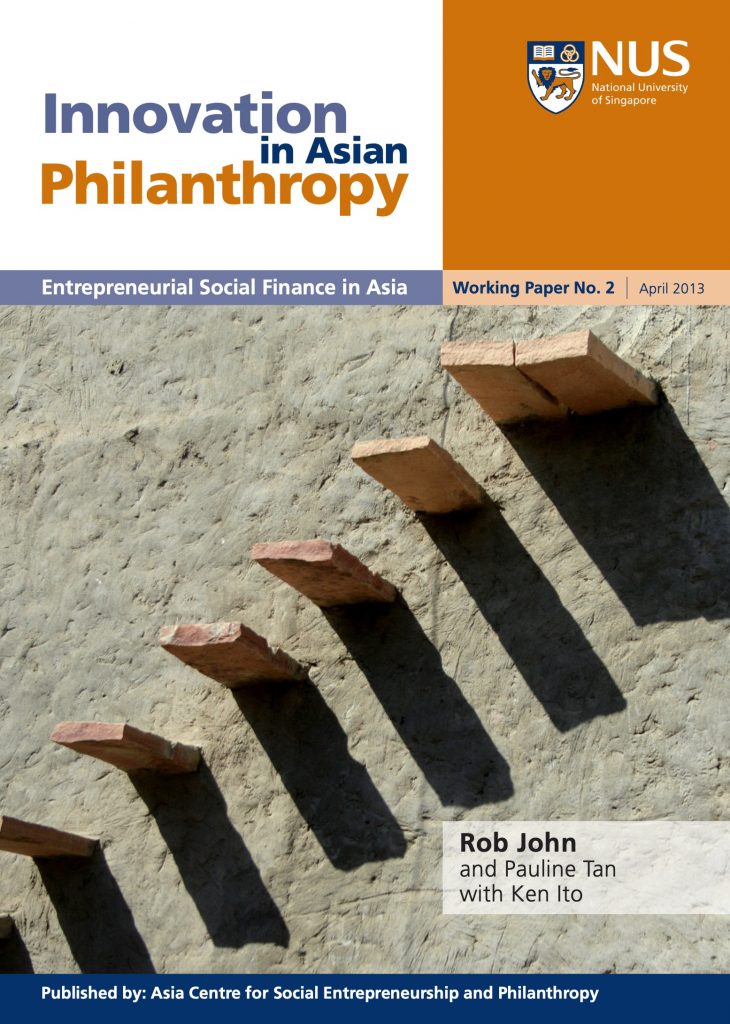April 2013
How philanthropy in Asia will develop in the coming decade matters. Despite economic progress having lifted millions out of poverty in the last 20 years, one half of Asia’s 1.63 billion people live on incomes of less than $2[1] a day. We don’t yet fully understand the impact of the 2008 global financial crisis on Asia, but the Asian Development Bank predicts that the number of poor in nearly half of its 25 developing member countries will increase. Even in countries with sustained economic growth rates, like China, there is an increasing environmental burden to bear because of growth and a challenge to social order from a widening gap between rich and poor. Personal wealth is being created in Asia Pacific at unprecedented levels. The number of high net worth individuals (HNWIs) grew by 1.6 percent from 2010 to 3.37 million, overtaking the number of wealthy in either North America or Europe. While over half of the region’s wealthy are in Japan, the number in developing economies is growing – 16.1 percent of HNWIs are in China. Eight of the 20 fastest growing HNWI populations are now in Asia Pacific, including Hong Kong, Vietnam, Sri Lanka, Indonesia, Singapore and India. This tension between widespread poverty and wealth creation potentially provides the foundation for the growth and maturation of private philanthropy in the region. Dennis Cheek asks if new wealth in Asia is a cause for rejoicing (Cheek, 2012). He points out that the astonishing growth in Asian private wealth needs to be matched by a new generation of Asian philanthropists with the leadership and imagination to “push for transformational projects that reinvent and massively improve social systems through a tough- minded, innovative and rigorous approach to managed change.” The entrenched depression of the global economy has resulted in a perceptible shift in attitude to extreme wealth. Politicians in the United States and Europe call for higher taxes on the wealthy, in China public scrutiny of the wealthy is a sensitive political issue. Gideon Rachman of The Financial Times speaks of a global backlash against the rich, and there has perhaps been no better time in recent history for those with wealth to demonstrate their responsibilities to use it through new, creative forms of philanthropy.
The Asia Centre for Social Entrepreneurship and Philanthropy (ACSEP) was established in 2011 within the National University of Singapore’s Business School. Its primary research interest lies at the intersection of the diverse practices of social entrepreneurship and philanthropy. This study on innovation in Asian philanthropy was commissioned by Fondation Lombard Odier, the foundation of the partners of one of Europe’s oldest private banks, established in Geneva in 1796. Our publication is the second in a series of ACSEP working papers concerned with what we have termed ‘entrepreneurial social finance’ in Asia, which explores how philanthropy is responding to the financial and non- financial needs of the region’s social entrepreneurs. The term philanthropy is most commonly associated with straightforward grant making, most usually making donations where all capital is lost and no return expected. In modern practice, philanthropy is
more sophisticated and diverse than this, wanting to utilise as many tools as possible with the goal of creating sustained social change. Recognising this, we prefer to define philanthropy, in this study, as the deployment of financial and human capital for primarily social impact. For this reason we investigate the growing interest in ‘impact investing,’ which seeks to use non-grant finance to maximise the social and financial outcomes by investing in social businesses.
Even within this understanding of philanthropy, there is a wide spectrum from ‘retail’ giving (the relatively small amounts given by the general public) to donations and specialised philanthropy vehicles of the comparatively wealthy. This study is intentionally focused on ‘high end’ philanthropy by HNWIs, and professionally managed philanthropy vehicles such as grant making foundations and impact investment funds. It is natural that those who give their wealth to charity or invest in social enterprises will expect these acts to make a difference. Some go further and see themselves as what Teresa Lloyd calls ‘catalysts for change’ in her book on Why the Wealthy Give. (Lloyd, 2004) Having the confidence that their giving can make a sustained, beneficial impact is what Paul Schervish calls the hyperagency of the Modern Medici: “While great expectations and grand aspiration exist across the financial spectrum,” it is the wealthy who can make things happen (Schervish, 2000). This is the underpinning of what, more recently, Bishop and Green have coined philanthrocapitalism.
We also explore the growing phenomenon of ‘giving circles,’ which engage HNWIs and the more modestly wealthy class of business professionals. Similarly, we recognise the value of non-financial forms of philanthropy, building upon traditional volunteerism to release business acumen and access to networks that is akin to angel investing in the commercial world. We have by and large avoided much of what is termed ‘corporate social responsibility’ (CSR) in the study. This is not to undervalue the importance of CSR in Asia, but to recognise that it is a distinct area of study, beyond our immediate interests. We have included examples of how young, entrepreneurial businesses in Asia have developed to imbed philanthropy into their organisation, where the founding principals are still involved in shaping the values and social responsibilities of the business.
[1] U.S. Dollars are used throughout this working paper, unless otherwise specified. Currency conversions, where used, are approximate.
The complimentary pdf version of the report can be accessed by submitting the form below.
The full list of the 101 foundations – including information such as their latest annual expenditure, grants disbursed, causes supported, website and email address – is available for purchase at $70. To purchase the full version, please click here. For charities, there is a 15% discount. Please email us at connect@soristic.asia for the discount code.

